Research Proposal on PTSD and War Museums
VerifiedAdded on 2020/02/19
|13
|2465
|103
AI Summary
This research proposal investigates the emotional impact of the Syonan Gallery exhibition on visitors suffering from Post Traumatic Stress Disorder (PTSD). It outlines the background, aims, objectives, and methodology of the study, emphasizing the dual nature of the exhibition's effects—both positive and negative. The proposal includes a literature review, hypothesis development, and a detailed research methodology, including sampling, data collection, and analysis techniques. Ethical considerations and limitations of the study are also discussed, along with a timeline for the research process.
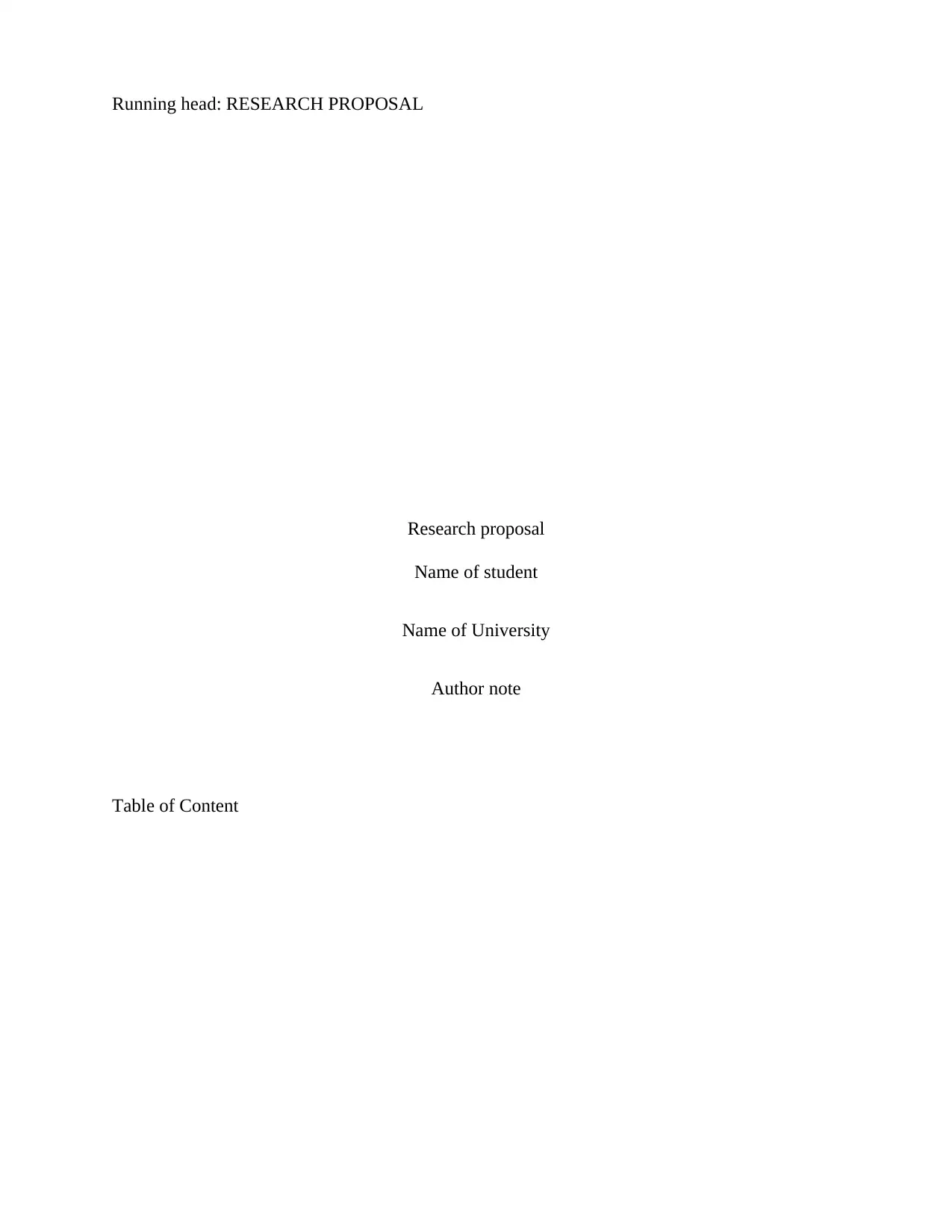
Running head: RESEARCH PROPOSAL
Research proposal
Name of student
Name of University
Author note
Table of Content
Research proposal
Name of student
Name of University
Author note
Table of Content
Paraphrase This Document
Need a fresh take? Get an instant paraphrase of this document with our AI Paraphraser
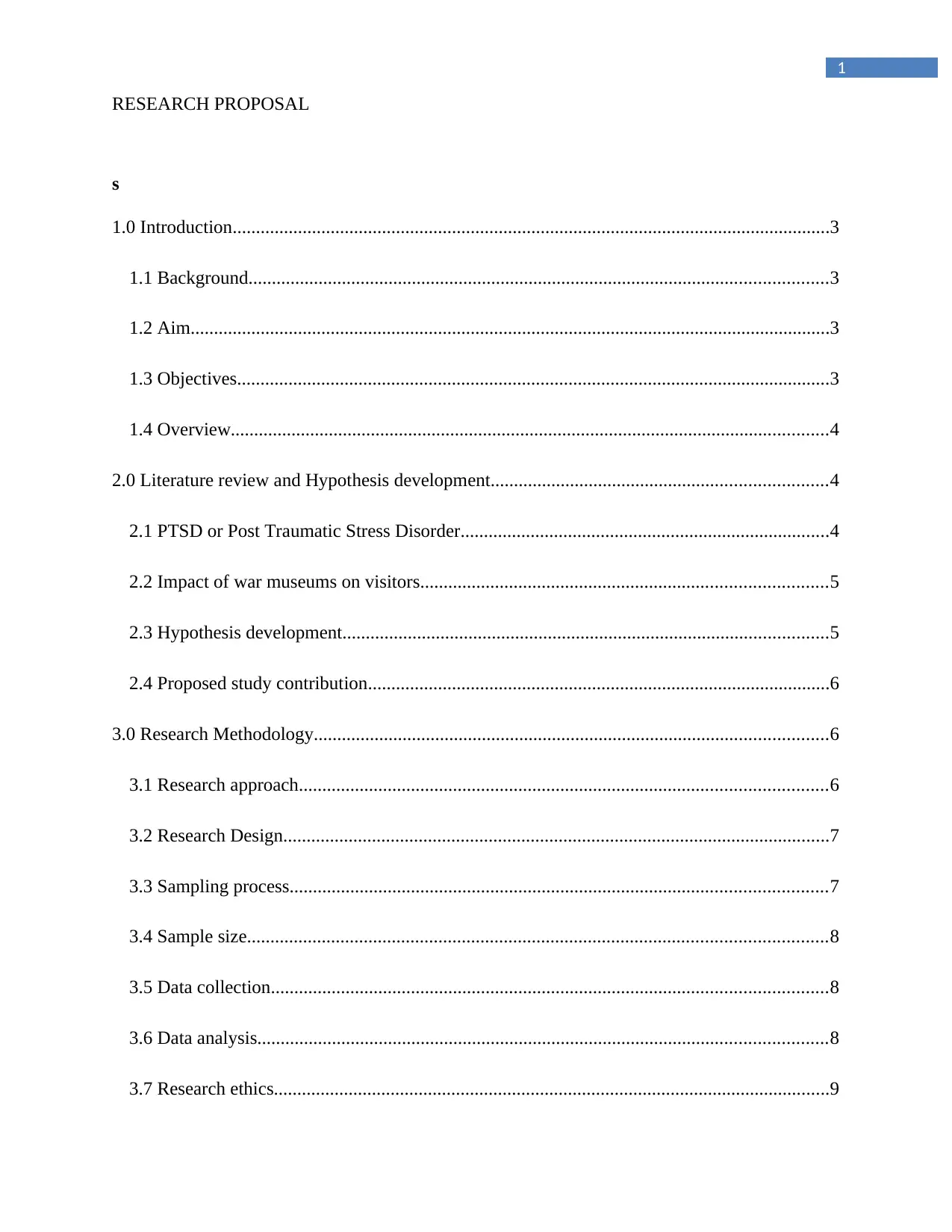
1
RESEARCH PROPOSAL
s
1.0 Introduction................................................................................................................................3
1.1 Background............................................................................................................................3
1.2 Aim.........................................................................................................................................3
1.3 Objectives...............................................................................................................................3
1.4 Overview................................................................................................................................4
2.0 Literature review and Hypothesis development........................................................................4
2.1 PTSD or Post Traumatic Stress Disorder...............................................................................4
2.2 Impact of war museums on visitors.......................................................................................5
2.3 Hypothesis development........................................................................................................5
2.4 Proposed study contribution...................................................................................................6
3.0 Research Methodology..............................................................................................................6
3.1 Research approach.................................................................................................................6
3.2 Research Design.....................................................................................................................7
3.3 Sampling process...................................................................................................................7
3.4 Sample size............................................................................................................................8
3.5 Data collection.......................................................................................................................8
3.6 Data analysis..........................................................................................................................8
3.7 Research ethics.......................................................................................................................9
RESEARCH PROPOSAL
s
1.0 Introduction................................................................................................................................3
1.1 Background............................................................................................................................3
1.2 Aim.........................................................................................................................................3
1.3 Objectives...............................................................................................................................3
1.4 Overview................................................................................................................................4
2.0 Literature review and Hypothesis development........................................................................4
2.1 PTSD or Post Traumatic Stress Disorder...............................................................................4
2.2 Impact of war museums on visitors.......................................................................................5
2.3 Hypothesis development........................................................................................................5
2.4 Proposed study contribution...................................................................................................6
3.0 Research Methodology..............................................................................................................6
3.1 Research approach.................................................................................................................6
3.2 Research Design.....................................................................................................................7
3.3 Sampling process...................................................................................................................7
3.4 Sample size............................................................................................................................8
3.5 Data collection.......................................................................................................................8
3.6 Data analysis..........................................................................................................................8
3.7 Research ethics.......................................................................................................................9

2
RESEARCH PROPOSAL
3.8 Limitations.............................................................................................................................9
4.0 Timeline.....................................................................................................................................9
References......................................................................................................................................11
RESEARCH PROPOSAL
3.8 Limitations.............................................................................................................................9
4.0 Timeline.....................................................................................................................................9
References......................................................................................................................................11
⊘ This is a preview!⊘
Do you want full access?
Subscribe today to unlock all pages.

Trusted by 1+ million students worldwide
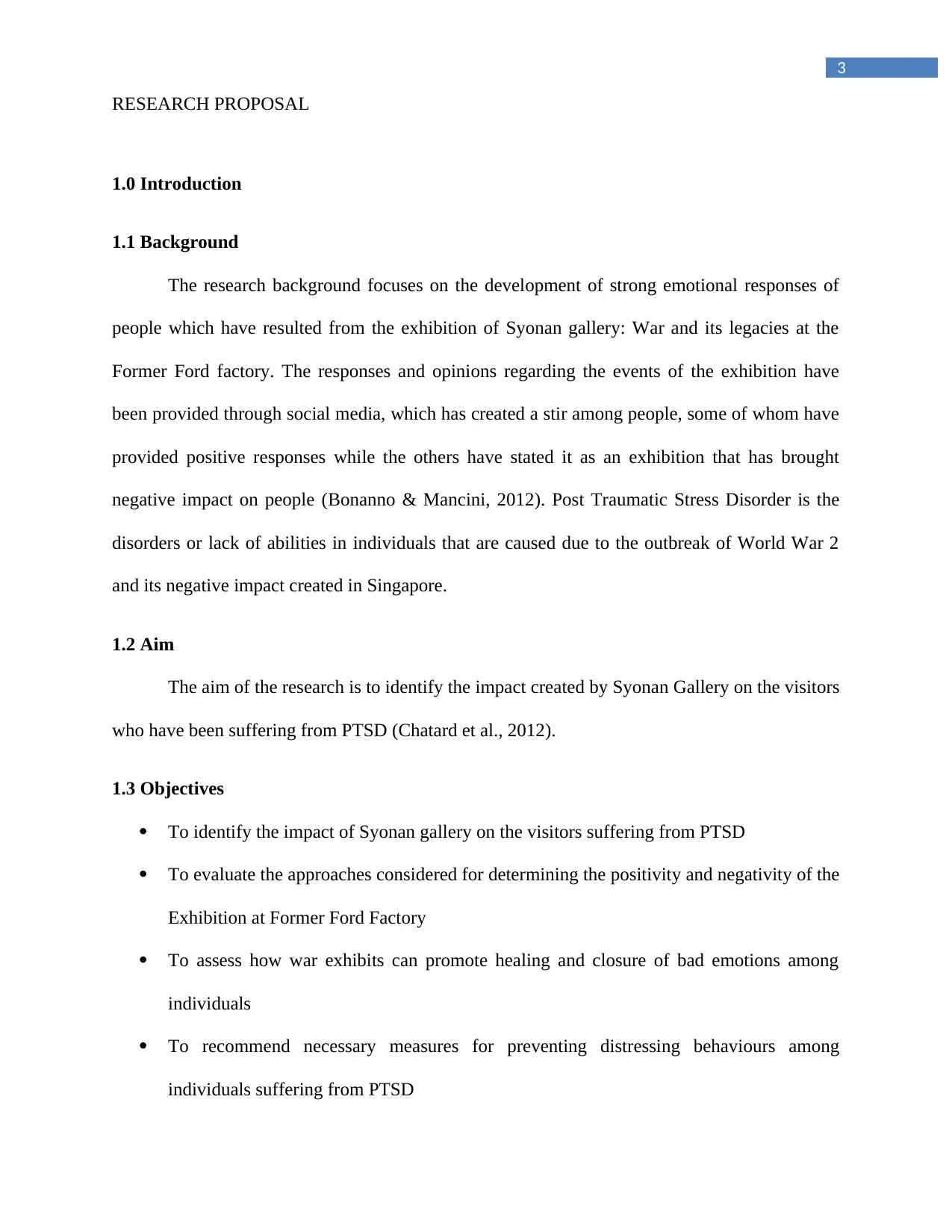
3
RESEARCH PROPOSAL
1.0 Introduction
1.1 Background
The research background focuses on the development of strong emotional responses of
people which have resulted from the exhibition of Syonan gallery: War and its legacies at the
Former Ford factory. The responses and opinions regarding the events of the exhibition have
been provided through social media, which has created a stir among people, some of whom have
provided positive responses while the others have stated it as an exhibition that has brought
negative impact on people (Bonanno & Mancini, 2012). Post Traumatic Stress Disorder is the
disorders or lack of abilities in individuals that are caused due to the outbreak of World War 2
and its negative impact created in Singapore.
1.2 Aim
The aim of the research is to identify the impact created by Syonan Gallery on the visitors
who have been suffering from PTSD (Chatard et al., 2012).
1.3 Objectives
To identify the impact of Syonan gallery on the visitors suffering from PTSD
To evaluate the approaches considered for determining the positivity and negativity of the
Exhibition at Former Ford Factory
To assess how war exhibits can promote healing and closure of bad emotions among
individuals
To recommend necessary measures for preventing distressing behaviours among
individuals suffering from PTSD
RESEARCH PROPOSAL
1.0 Introduction
1.1 Background
The research background focuses on the development of strong emotional responses of
people which have resulted from the exhibition of Syonan gallery: War and its legacies at the
Former Ford factory. The responses and opinions regarding the events of the exhibition have
been provided through social media, which has created a stir among people, some of whom have
provided positive responses while the others have stated it as an exhibition that has brought
negative impact on people (Bonanno & Mancini, 2012). Post Traumatic Stress Disorder is the
disorders or lack of abilities in individuals that are caused due to the outbreak of World War 2
and its negative impact created in Singapore.
1.2 Aim
The aim of the research is to identify the impact created by Syonan Gallery on the visitors
who have been suffering from PTSD (Chatard et al., 2012).
1.3 Objectives
To identify the impact of Syonan gallery on the visitors suffering from PTSD
To evaluate the approaches considered for determining the positivity and negativity of the
Exhibition at Former Ford Factory
To assess how war exhibits can promote healing and closure of bad emotions among
individuals
To recommend necessary measures for preventing distressing behaviours among
individuals suffering from PTSD
Paraphrase This Document
Need a fresh take? Get an instant paraphrase of this document with our AI Paraphraser
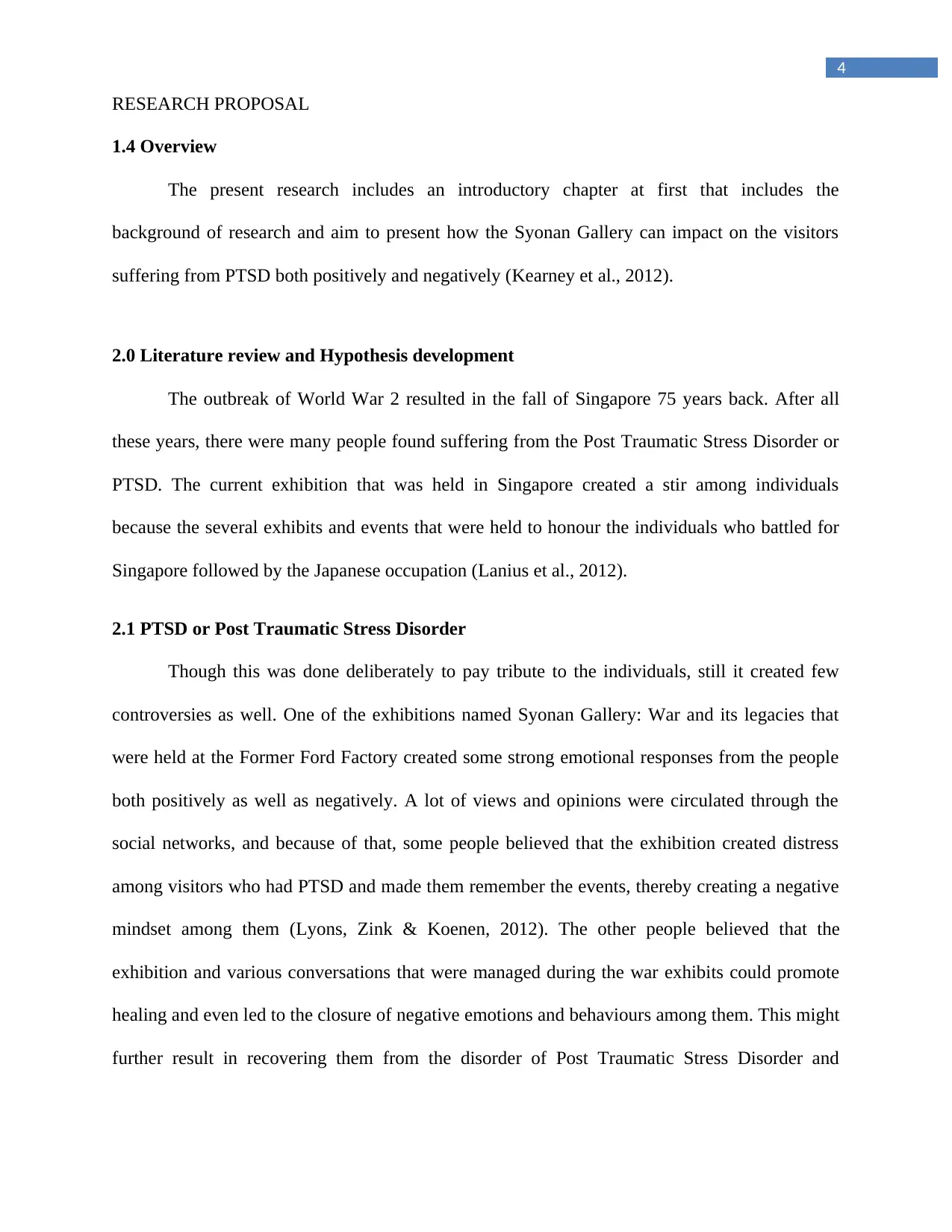
4
RESEARCH PROPOSAL
1.4 Overview
The present research includes an introductory chapter at first that includes the
background of research and aim to present how the Syonan Gallery can impact on the visitors
suffering from PTSD both positively and negatively (Kearney et al., 2012).
2.0 Literature review and Hypothesis development
The outbreak of World War 2 resulted in the fall of Singapore 75 years back. After all
these years, there were many people found suffering from the Post Traumatic Stress Disorder or
PTSD. The current exhibition that was held in Singapore created a stir among individuals
because the several exhibits and events that were held to honour the individuals who battled for
Singapore followed by the Japanese occupation (Lanius et al., 2012).
2.1 PTSD or Post Traumatic Stress Disorder
Though this was done deliberately to pay tribute to the individuals, still it created few
controversies as well. One of the exhibitions named Syonan Gallery: War and its legacies that
were held at the Former Ford Factory created some strong emotional responses from the people
both positively as well as negatively. A lot of views and opinions were circulated through the
social networks, and because of that, some people believed that the exhibition created distress
among visitors who had PTSD and made them remember the events, thereby creating a negative
mindset among them (Lyons, Zink & Koenen, 2012). The other people believed that the
exhibition and various conversations that were managed during the war exhibits could promote
healing and even led to the closure of negative emotions and behaviours among them. This might
further result in recovering them from the disorder of Post Traumatic Stress Disorder and
RESEARCH PROPOSAL
1.4 Overview
The present research includes an introductory chapter at first that includes the
background of research and aim to present how the Syonan Gallery can impact on the visitors
suffering from PTSD both positively and negatively (Kearney et al., 2012).
2.0 Literature review and Hypothesis development
The outbreak of World War 2 resulted in the fall of Singapore 75 years back. After all
these years, there were many people found suffering from the Post Traumatic Stress Disorder or
PTSD. The current exhibition that was held in Singapore created a stir among individuals
because the several exhibits and events that were held to honour the individuals who battled for
Singapore followed by the Japanese occupation (Lanius et al., 2012).
2.1 PTSD or Post Traumatic Stress Disorder
Though this was done deliberately to pay tribute to the individuals, still it created few
controversies as well. One of the exhibitions named Syonan Gallery: War and its legacies that
were held at the Former Ford Factory created some strong emotional responses from the people
both positively as well as negatively. A lot of views and opinions were circulated through the
social networks, and because of that, some people believed that the exhibition created distress
among visitors who had PTSD and made them remember the events, thereby creating a negative
mindset among them (Lyons, Zink & Koenen, 2012). The other people believed that the
exhibition and various conversations that were managed during the war exhibits could promote
healing and even led to the closure of negative emotions and behaviours among them. This might
further result in recovering them from the disorder of Post Traumatic Stress Disorder and
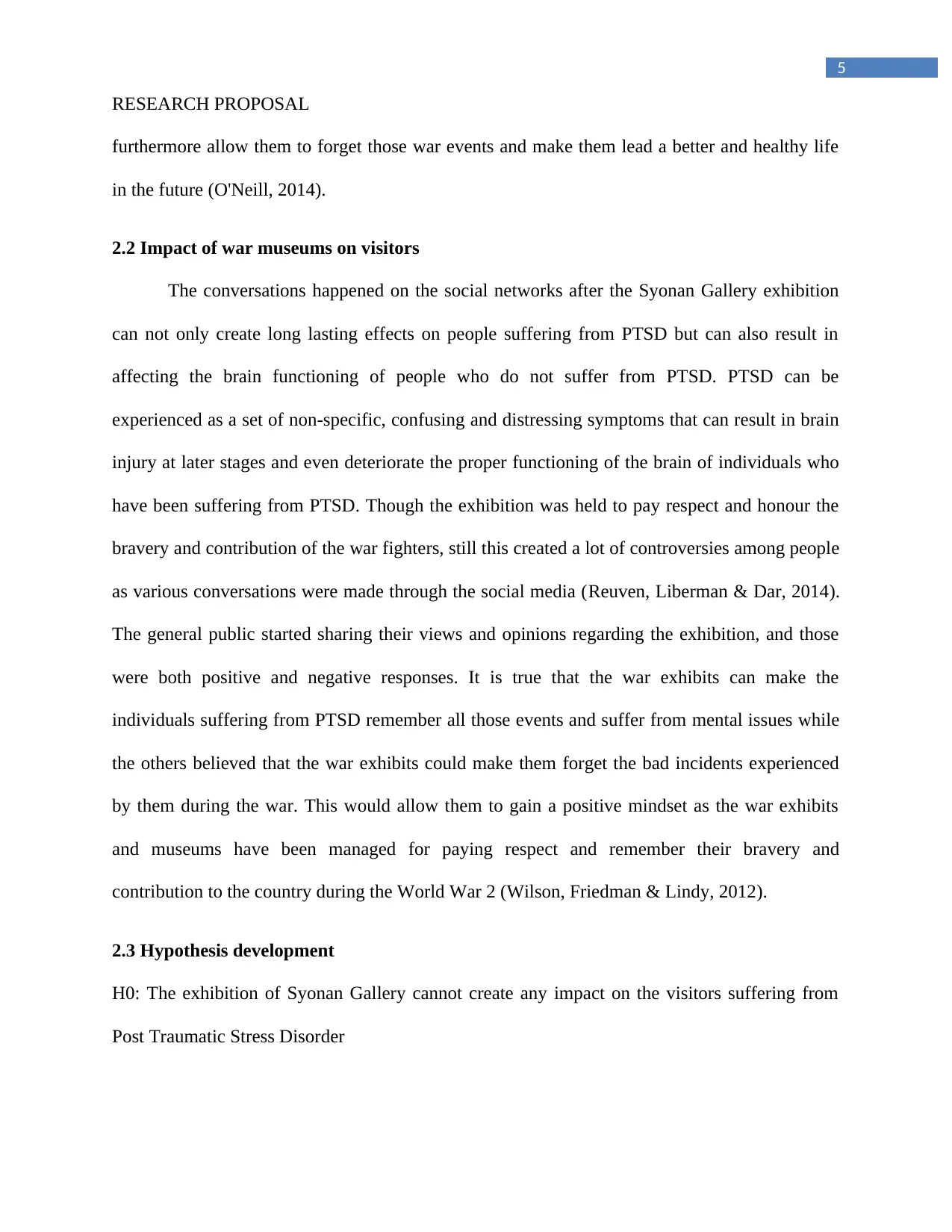
5
RESEARCH PROPOSAL
furthermore allow them to forget those war events and make them lead a better and healthy life
in the future (O'Neill, 2014).
2.2 Impact of war museums on visitors
The conversations happened on the social networks after the Syonan Gallery exhibition
can not only create long lasting effects on people suffering from PTSD but can also result in
affecting the brain functioning of people who do not suffer from PTSD. PTSD can be
experienced as a set of non-specific, confusing and distressing symptoms that can result in brain
injury at later stages and even deteriorate the proper functioning of the brain of individuals who
have been suffering from PTSD. Though the exhibition was held to pay respect and honour the
bravery and contribution of the war fighters, still this created a lot of controversies among people
as various conversations were made through the social media (Reuven, Liberman & Dar, 2014).
The general public started sharing their views and opinions regarding the exhibition, and those
were both positive and negative responses. It is true that the war exhibits can make the
individuals suffering from PTSD remember all those events and suffer from mental issues while
the others believed that the war exhibits could make them forget the bad incidents experienced
by them during the war. This would allow them to gain a positive mindset as the war exhibits
and museums have been managed for paying respect and remember their bravery and
contribution to the country during the World War 2 (Wilson, Friedman & Lindy, 2012).
2.3 Hypothesis development
H0: The exhibition of Syonan Gallery cannot create any impact on the visitors suffering from
Post Traumatic Stress Disorder
RESEARCH PROPOSAL
furthermore allow them to forget those war events and make them lead a better and healthy life
in the future (O'Neill, 2014).
2.2 Impact of war museums on visitors
The conversations happened on the social networks after the Syonan Gallery exhibition
can not only create long lasting effects on people suffering from PTSD but can also result in
affecting the brain functioning of people who do not suffer from PTSD. PTSD can be
experienced as a set of non-specific, confusing and distressing symptoms that can result in brain
injury at later stages and even deteriorate the proper functioning of the brain of individuals who
have been suffering from PTSD. Though the exhibition was held to pay respect and honour the
bravery and contribution of the war fighters, still this created a lot of controversies among people
as various conversations were made through the social media (Reuven, Liberman & Dar, 2014).
The general public started sharing their views and opinions regarding the exhibition, and those
were both positive and negative responses. It is true that the war exhibits can make the
individuals suffering from PTSD remember all those events and suffer from mental issues while
the others believed that the war exhibits could make them forget the bad incidents experienced
by them during the war. This would allow them to gain a positive mindset as the war exhibits
and museums have been managed for paying respect and remember their bravery and
contribution to the country during the World War 2 (Wilson, Friedman & Lindy, 2012).
2.3 Hypothesis development
H0: The exhibition of Syonan Gallery cannot create any impact on the visitors suffering from
Post Traumatic Stress Disorder
⊘ This is a preview!⊘
Do you want full access?
Subscribe today to unlock all pages.

Trusted by 1+ million students worldwide
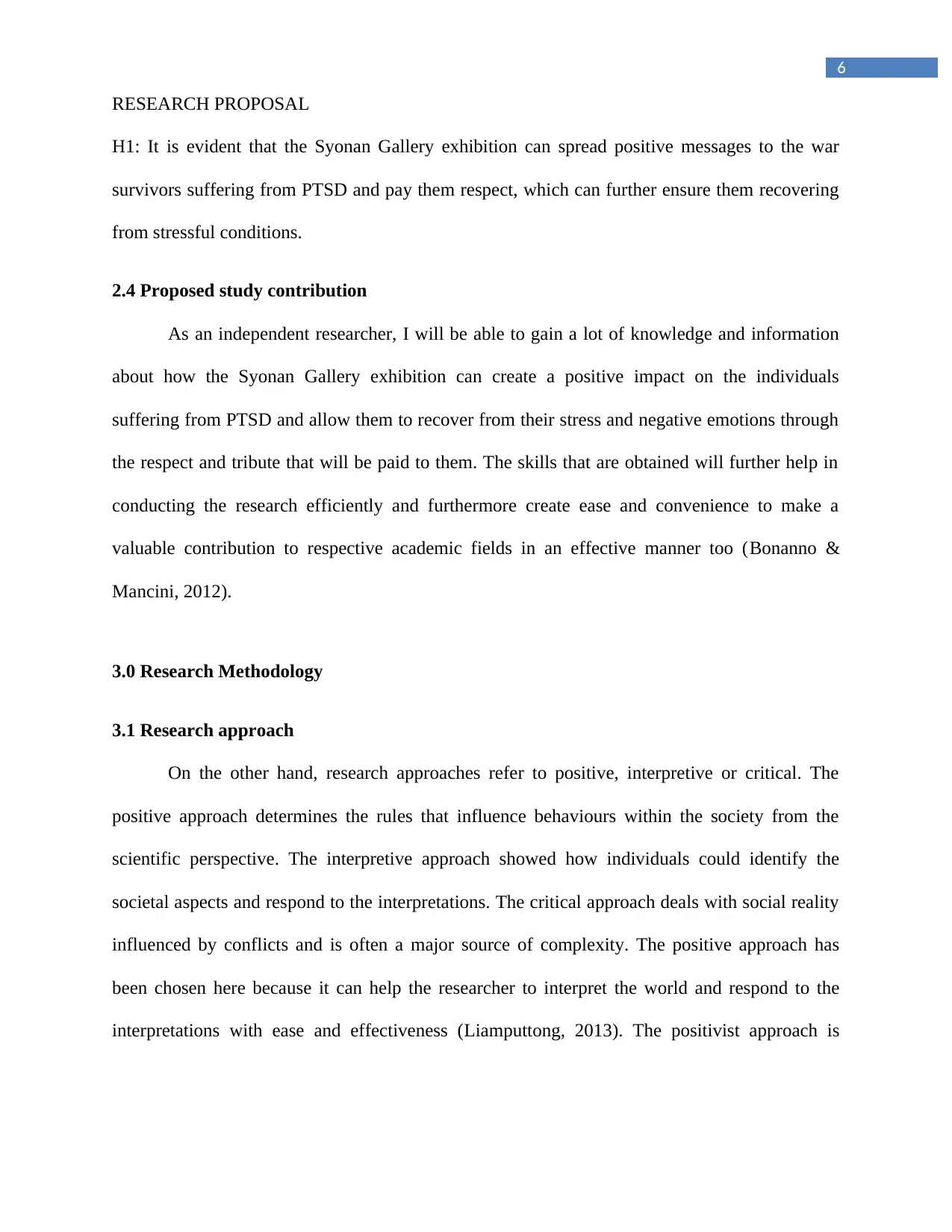
6
RESEARCH PROPOSAL
H1: It is evident that the Syonan Gallery exhibition can spread positive messages to the war
survivors suffering from PTSD and pay them respect, which can further ensure them recovering
from stressful conditions.
2.4 Proposed study contribution
As an independent researcher, I will be able to gain a lot of knowledge and information
about how the Syonan Gallery exhibition can create a positive impact on the individuals
suffering from PTSD and allow them to recover from their stress and negative emotions through
the respect and tribute that will be paid to them. The skills that are obtained will further help in
conducting the research efficiently and furthermore create ease and convenience to make a
valuable contribution to respective academic fields in an effective manner too (Bonanno &
Mancini, 2012).
3.0 Research Methodology
3.1 Research approach
On the other hand, research approaches refer to positive, interpretive or critical. The
positive approach determines the rules that influence behaviours within the society from the
scientific perspective. The interpretive approach showed how individuals could identify the
societal aspects and respond to the interpretations. The critical approach deals with social reality
influenced by conflicts and is often a major source of complexity. The positive approach has
been chosen here because it can help the researcher to interpret the world and respond to the
interpretations with ease and effectiveness (Liamputtong, 2013). The positivist approach is
RESEARCH PROPOSAL
H1: It is evident that the Syonan Gallery exhibition can spread positive messages to the war
survivors suffering from PTSD and pay them respect, which can further ensure them recovering
from stressful conditions.
2.4 Proposed study contribution
As an independent researcher, I will be able to gain a lot of knowledge and information
about how the Syonan Gallery exhibition can create a positive impact on the individuals
suffering from PTSD and allow them to recover from their stress and negative emotions through
the respect and tribute that will be paid to them. The skills that are obtained will further help in
conducting the research efficiently and furthermore create ease and convenience to make a
valuable contribution to respective academic fields in an effective manner too (Bonanno &
Mancini, 2012).
3.0 Research Methodology
3.1 Research approach
On the other hand, research approaches refer to positive, interpretive or critical. The
positive approach determines the rules that influence behaviours within the society from the
scientific perspective. The interpretive approach showed how individuals could identify the
societal aspects and respond to the interpretations. The critical approach deals with social reality
influenced by conflicts and is often a major source of complexity. The positive approach has
been chosen here because it can help the researcher to interpret the world and respond to the
interpretations with ease and effectiveness (Liamputtong, 2013). The positivist approach is
Paraphrase This Document
Need a fresh take? Get an instant paraphrase of this document with our AI Paraphraser
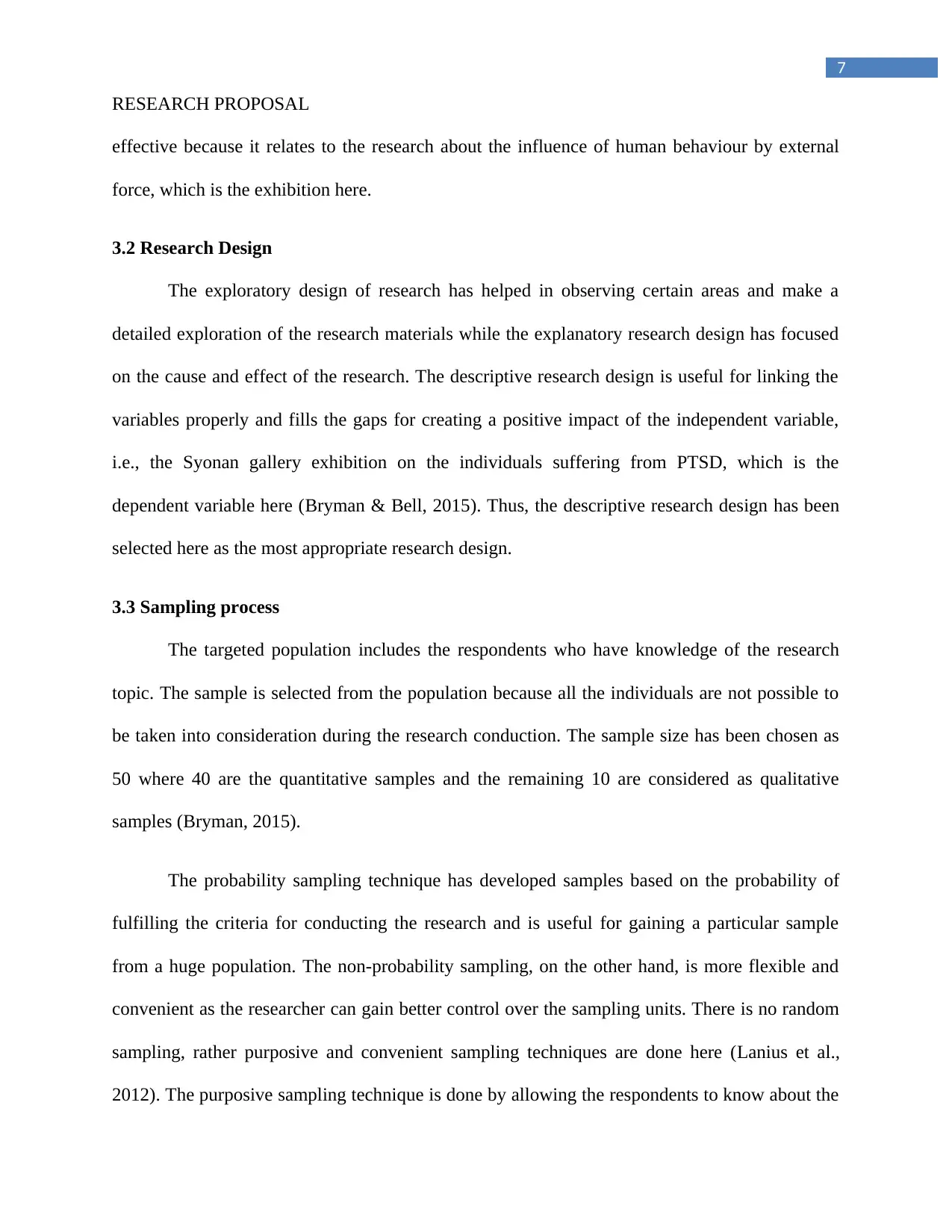
7
RESEARCH PROPOSAL
effective because it relates to the research about the influence of human behaviour by external
force, which is the exhibition here.
3.2 Research Design
The exploratory design of research has helped in observing certain areas and make a
detailed exploration of the research materials while the explanatory research design has focused
on the cause and effect of the research. The descriptive research design is useful for linking the
variables properly and fills the gaps for creating a positive impact of the independent variable,
i.e., the Syonan gallery exhibition on the individuals suffering from PTSD, which is the
dependent variable here (Bryman & Bell, 2015). Thus, the descriptive research design has been
selected here as the most appropriate research design.
3.3 Sampling process
The targeted population includes the respondents who have knowledge of the research
topic. The sample is selected from the population because all the individuals are not possible to
be taken into consideration during the research conduction. The sample size has been chosen as
50 where 40 are the quantitative samples and the remaining 10 are considered as qualitative
samples (Bryman, 2015).
The probability sampling technique has developed samples based on the probability of
fulfilling the criteria for conducting the research and is useful for gaining a particular sample
from a huge population. The non-probability sampling, on the other hand, is more flexible and
convenient as the researcher can gain better control over the sampling units. There is no random
sampling, rather purposive and convenient sampling techniques are done here (Lanius et al.,
2012). The purposive sampling technique is done by allowing the respondents to know about the
RESEARCH PROPOSAL
effective because it relates to the research about the influence of human behaviour by external
force, which is the exhibition here.
3.2 Research Design
The exploratory design of research has helped in observing certain areas and make a
detailed exploration of the research materials while the explanatory research design has focused
on the cause and effect of the research. The descriptive research design is useful for linking the
variables properly and fills the gaps for creating a positive impact of the independent variable,
i.e., the Syonan gallery exhibition on the individuals suffering from PTSD, which is the
dependent variable here (Bryman & Bell, 2015). Thus, the descriptive research design has been
selected here as the most appropriate research design.
3.3 Sampling process
The targeted population includes the respondents who have knowledge of the research
topic. The sample is selected from the population because all the individuals are not possible to
be taken into consideration during the research conduction. The sample size has been chosen as
50 where 40 are the quantitative samples and the remaining 10 are considered as qualitative
samples (Bryman, 2015).
The probability sampling technique has developed samples based on the probability of
fulfilling the criteria for conducting the research and is useful for gaining a particular sample
from a huge population. The non-probability sampling, on the other hand, is more flexible and
convenient as the researcher can gain better control over the sampling units. There is no random
sampling, rather purposive and convenient sampling techniques are done here (Lanius et al.,
2012). The purposive sampling technique is done by allowing the respondents to know about the
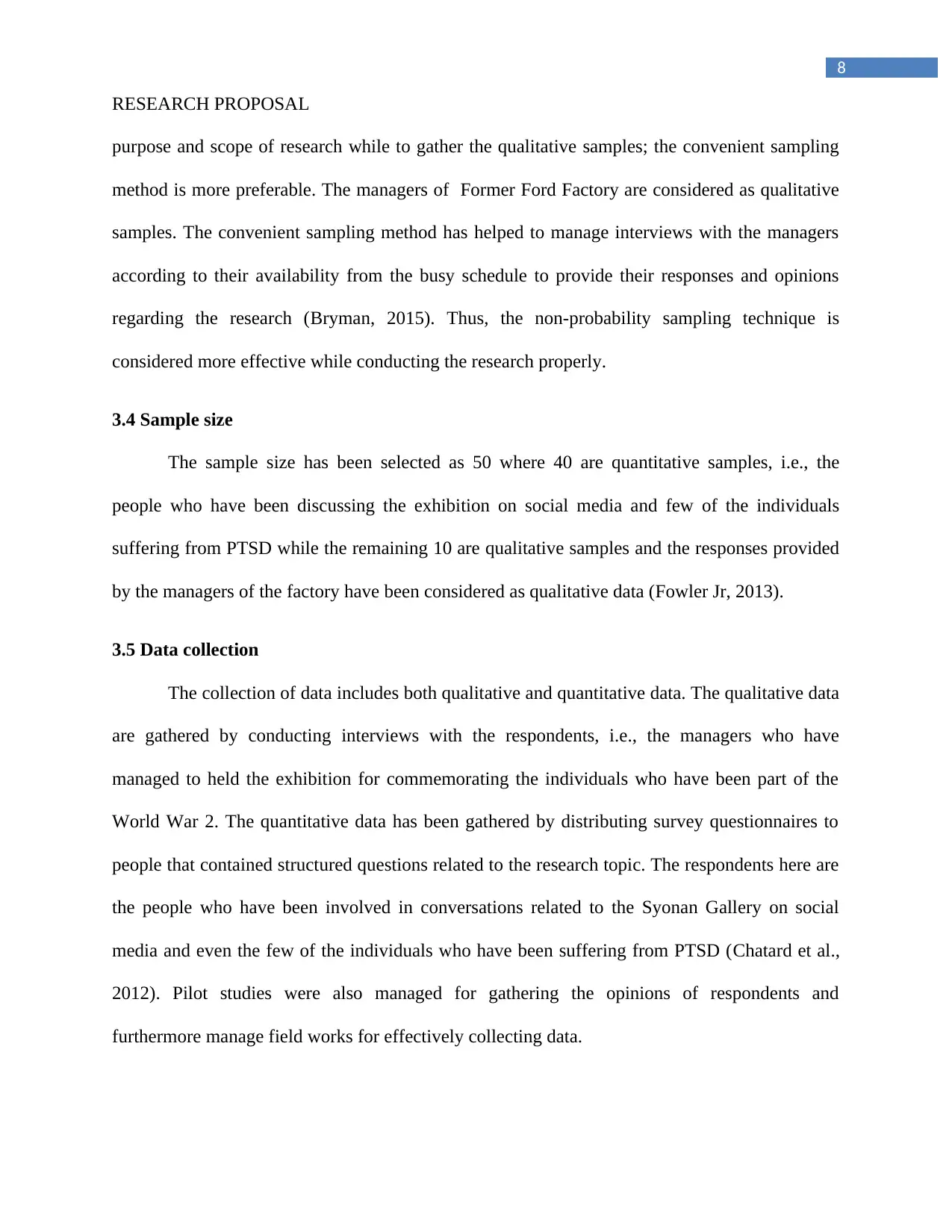
8
RESEARCH PROPOSAL
purpose and scope of research while to gather the qualitative samples; the convenient sampling
method is more preferable. The managers of Former Ford Factory are considered as qualitative
samples. The convenient sampling method has helped to manage interviews with the managers
according to their availability from the busy schedule to provide their responses and opinions
regarding the research (Bryman, 2015). Thus, the non-probability sampling technique is
considered more effective while conducting the research properly.
3.4 Sample size
The sample size has been selected as 50 where 40 are quantitative samples, i.e., the
people who have been discussing the exhibition on social media and few of the individuals
suffering from PTSD while the remaining 10 are qualitative samples and the responses provided
by the managers of the factory have been considered as qualitative data (Fowler Jr, 2013).
3.5 Data collection
The collection of data includes both qualitative and quantitative data. The qualitative data
are gathered by conducting interviews with the respondents, i.e., the managers who have
managed to held the exhibition for commemorating the individuals who have been part of the
World War 2. The quantitative data has been gathered by distributing survey questionnaires to
people that contained structured questions related to the research topic. The respondents here are
the people who have been involved in conversations related to the Syonan Gallery on social
media and even the few of the individuals who have been suffering from PTSD (Chatard et al.,
2012). Pilot studies were also managed for gathering the opinions of respondents and
furthermore manage field works for effectively collecting data.
RESEARCH PROPOSAL
purpose and scope of research while to gather the qualitative samples; the convenient sampling
method is more preferable. The managers of Former Ford Factory are considered as qualitative
samples. The convenient sampling method has helped to manage interviews with the managers
according to their availability from the busy schedule to provide their responses and opinions
regarding the research (Bryman, 2015). Thus, the non-probability sampling technique is
considered more effective while conducting the research properly.
3.4 Sample size
The sample size has been selected as 50 where 40 are quantitative samples, i.e., the
people who have been discussing the exhibition on social media and few of the individuals
suffering from PTSD while the remaining 10 are qualitative samples and the responses provided
by the managers of the factory have been considered as qualitative data (Fowler Jr, 2013).
3.5 Data collection
The collection of data includes both qualitative and quantitative data. The qualitative data
are gathered by conducting interviews with the respondents, i.e., the managers who have
managed to held the exhibition for commemorating the individuals who have been part of the
World War 2. The quantitative data has been gathered by distributing survey questionnaires to
people that contained structured questions related to the research topic. The respondents here are
the people who have been involved in conversations related to the Syonan Gallery on social
media and even the few of the individuals who have been suffering from PTSD (Chatard et al.,
2012). Pilot studies were also managed for gathering the opinions of respondents and
furthermore manage field works for effectively collecting data.
⊘ This is a preview!⊘
Do you want full access?
Subscribe today to unlock all pages.

Trusted by 1+ million students worldwide
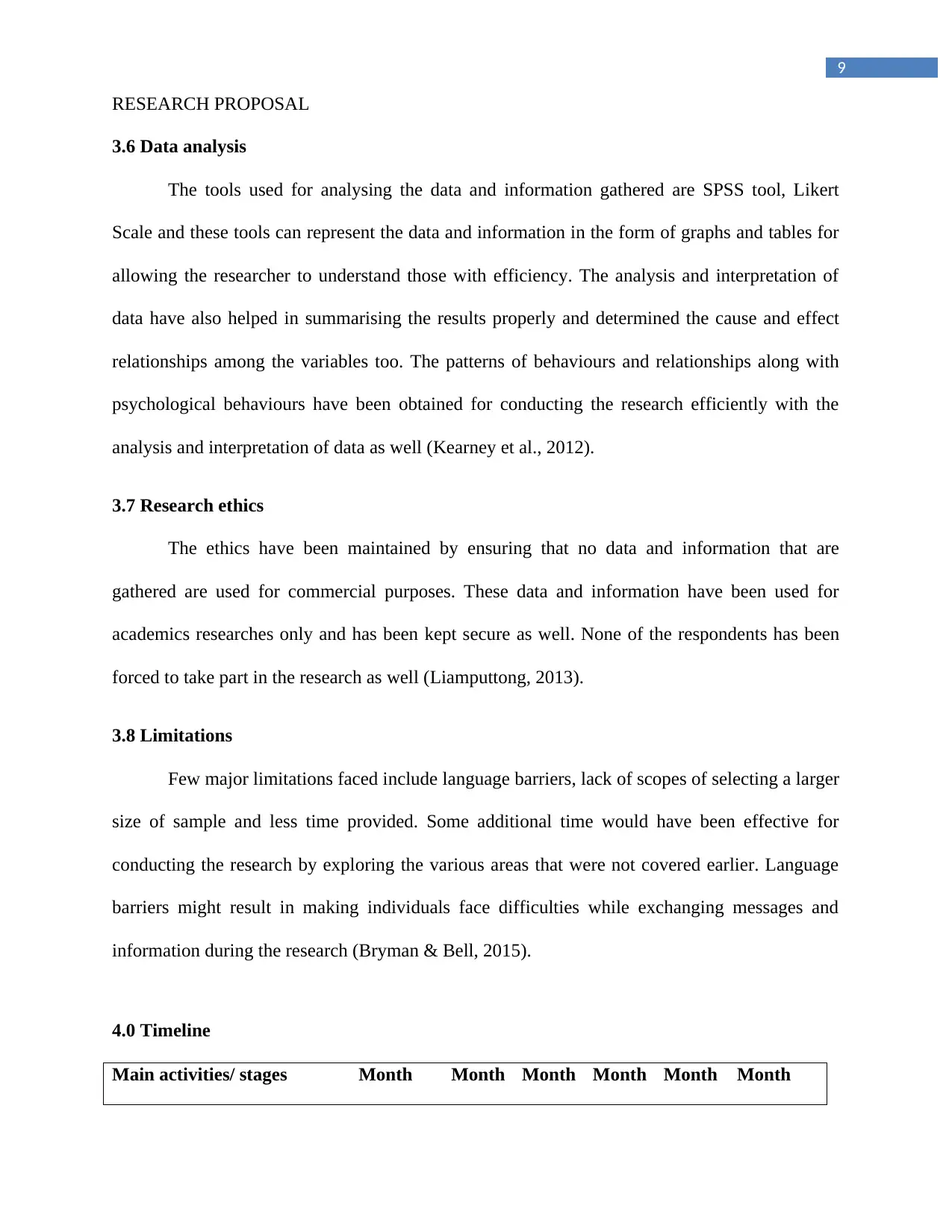
9
RESEARCH PROPOSAL
3.6 Data analysis
The tools used for analysing the data and information gathered are SPSS tool, Likert
Scale and these tools can represent the data and information in the form of graphs and tables for
allowing the researcher to understand those with efficiency. The analysis and interpretation of
data have also helped in summarising the results properly and determined the cause and effect
relationships among the variables too. The patterns of behaviours and relationships along with
psychological behaviours have been obtained for conducting the research efficiently with the
analysis and interpretation of data as well (Kearney et al., 2012).
3.7 Research ethics
The ethics have been maintained by ensuring that no data and information that are
gathered are used for commercial purposes. These data and information have been used for
academics researches only and has been kept secure as well. None of the respondents has been
forced to take part in the research as well (Liamputtong, 2013).
3.8 Limitations
Few major limitations faced include language barriers, lack of scopes of selecting a larger
size of sample and less time provided. Some additional time would have been effective for
conducting the research by exploring the various areas that were not covered earlier. Language
barriers might result in making individuals face difficulties while exchanging messages and
information during the research (Bryman & Bell, 2015).
4.0 Timeline
Main activities/ stages Month Month Month Month Month Month
RESEARCH PROPOSAL
3.6 Data analysis
The tools used for analysing the data and information gathered are SPSS tool, Likert
Scale and these tools can represent the data and information in the form of graphs and tables for
allowing the researcher to understand those with efficiency. The analysis and interpretation of
data have also helped in summarising the results properly and determined the cause and effect
relationships among the variables too. The patterns of behaviours and relationships along with
psychological behaviours have been obtained for conducting the research efficiently with the
analysis and interpretation of data as well (Kearney et al., 2012).
3.7 Research ethics
The ethics have been maintained by ensuring that no data and information that are
gathered are used for commercial purposes. These data and information have been used for
academics researches only and has been kept secure as well. None of the respondents has been
forced to take part in the research as well (Liamputtong, 2013).
3.8 Limitations
Few major limitations faced include language barriers, lack of scopes of selecting a larger
size of sample and less time provided. Some additional time would have been effective for
conducting the research by exploring the various areas that were not covered earlier. Language
barriers might result in making individuals face difficulties while exchanging messages and
information during the research (Bryman & Bell, 2015).
4.0 Timeline
Main activities/ stages Month Month Month Month Month Month
Paraphrase This Document
Need a fresh take? Get an instant paraphrase of this document with our AI Paraphraser
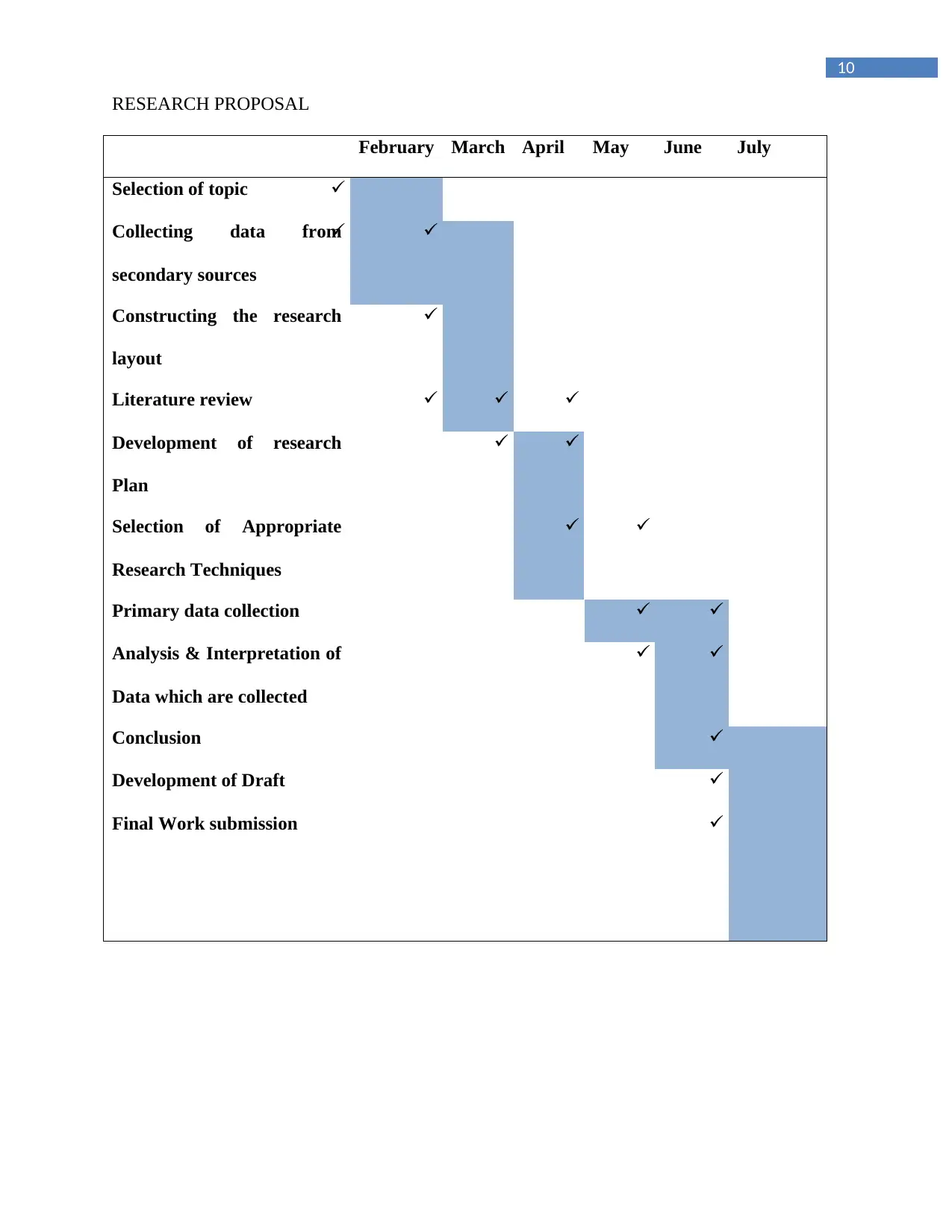
10
RESEARCH PROPOSAL
February March April May June July
Selection of topic
Collecting data from
secondary sources
Constructing the research
layout
Literature review
Development of research
Plan
Selection of Appropriate
Research Techniques
Primary data collection
Analysis & Interpretation of
Data which are collected
Conclusion
Development of Draft
Final Work submission
RESEARCH PROPOSAL
February March April May June July
Selection of topic
Collecting data from
secondary sources
Constructing the research
layout
Literature review
Development of research
Plan
Selection of Appropriate
Research Techniques
Primary data collection
Analysis & Interpretation of
Data which are collected
Conclusion
Development of Draft
Final Work submission
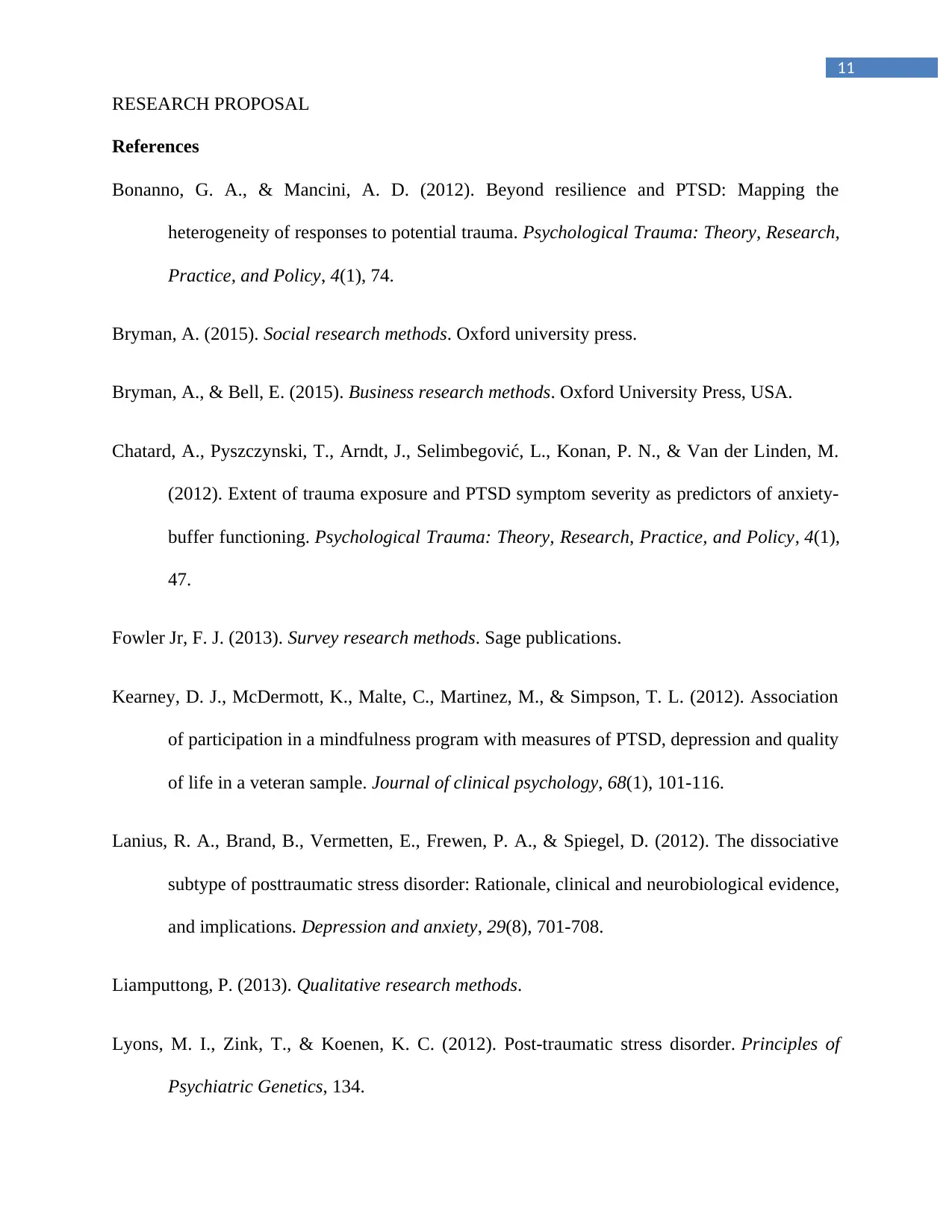
11
RESEARCH PROPOSAL
References
Bonanno, G. A., & Mancini, A. D. (2012). Beyond resilience and PTSD: Mapping the
heterogeneity of responses to potential trauma. Psychological Trauma: Theory, Research,
Practice, and Policy, 4(1), 74.
Bryman, A. (2015). Social research methods. Oxford university press.
Bryman, A., & Bell, E. (2015). Business research methods. Oxford University Press, USA.
Chatard, A., Pyszczynski, T., Arndt, J., Selimbegović, L., Konan, P. N., & Van der Linden, M.
(2012). Extent of trauma exposure and PTSD symptom severity as predictors of anxiety-
buffer functioning. Psychological Trauma: Theory, Research, Practice, and Policy, 4(1),
47.
Fowler Jr, F. J. (2013). Survey research methods. Sage publications.
Kearney, D. J., McDermott, K., Malte, C., Martinez, M., & Simpson, T. L. (2012). Association
of participation in a mindfulness program with measures of PTSD, depression and quality
of life in a veteran sample. Journal of clinical psychology, 68(1), 101-116.
Lanius, R. A., Brand, B., Vermetten, E., Frewen, P. A., & Spiegel, D. (2012). The dissociative
subtype of posttraumatic stress disorder: Rationale, clinical and neurobiological evidence,
and implications. Depression and anxiety, 29(8), 701-708.
Liamputtong, P. (2013). Qualitative research methods.
Lyons, M. I., Zink, T., & Koenen, K. C. (2012). Post-traumatic stress disorder. Principles of
Psychiatric Genetics, 134.
RESEARCH PROPOSAL
References
Bonanno, G. A., & Mancini, A. D. (2012). Beyond resilience and PTSD: Mapping the
heterogeneity of responses to potential trauma. Psychological Trauma: Theory, Research,
Practice, and Policy, 4(1), 74.
Bryman, A. (2015). Social research methods. Oxford university press.
Bryman, A., & Bell, E. (2015). Business research methods. Oxford University Press, USA.
Chatard, A., Pyszczynski, T., Arndt, J., Selimbegović, L., Konan, P. N., & Van der Linden, M.
(2012). Extent of trauma exposure and PTSD symptom severity as predictors of anxiety-
buffer functioning. Psychological Trauma: Theory, Research, Practice, and Policy, 4(1),
47.
Fowler Jr, F. J. (2013). Survey research methods. Sage publications.
Kearney, D. J., McDermott, K., Malte, C., Martinez, M., & Simpson, T. L. (2012). Association
of participation in a mindfulness program with measures of PTSD, depression and quality
of life in a veteran sample. Journal of clinical psychology, 68(1), 101-116.
Lanius, R. A., Brand, B., Vermetten, E., Frewen, P. A., & Spiegel, D. (2012). The dissociative
subtype of posttraumatic stress disorder: Rationale, clinical and neurobiological evidence,
and implications. Depression and anxiety, 29(8), 701-708.
Liamputtong, P. (2013). Qualitative research methods.
Lyons, M. I., Zink, T., & Koenen, K. C. (2012). Post-traumatic stress disorder. Principles of
Psychiatric Genetics, 134.
⊘ This is a preview!⊘
Do you want full access?
Subscribe today to unlock all pages.

Trusted by 1+ million students worldwide
1 out of 13
Your All-in-One AI-Powered Toolkit for Academic Success.
+13062052269
info@desklib.com
Available 24*7 on WhatsApp / Email
![[object Object]](/_next/static/media/star-bottom.7253800d.svg)
Unlock your academic potential
Copyright © 2020–2025 A2Z Services. All Rights Reserved. Developed and managed by ZUCOL.